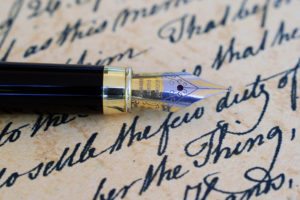Writing Tools – things to help you get your writing done
Thorin Klosowski at Life Hacker reviews Ulysses, a plain text writing tool. What are some of your favorite apps or tools to help get your writing done?
Writing Tools – things to help you get your writing done
Thorin Klosowski at Life Hacker reviews Ulysses, a plain text writing tool. What are some of your favorite apps or tools to help get your writing done?
Quick links, bringing you great articles on writing from all over the web.
Have you ever thought of becoming an editor and helping other writers shape their work? Roz Morris at Nail Your Novel shares the different types of editor and what it takes to become one.
 Rachel Anderson asks: How did you get into editing? Did you start writing first and then take on editing as a natural second, or was it out of necessity since there are more opportunities for editors than writers?
Rachel Anderson asks: How did you get into editing? Did you start writing first and then take on editing as a natural second, or was it out of necessity since there are more opportunities for editors than writers?
Oof, talk about cutting to the quick. It’s certainly tricky to make a living as a full-time writer. So most writers also use their wordsmithing in some other way – teaching or working in the publishing trade.
But does that mean all writers could be editors? Not necessarily. There’s a lot of difference between tidying your own work and shaping someone else’s to professional standards.
And you need different skills for the various strains of editing.
Copy editing and proof reading These are the nitpicky, forensic phases. Fact-checking and querying. Reading for consistency, clarity, correctness, house style, possible libel. The copy editor and proof reader are a human error trap – they have to catch anything that might be inaccurate, or would spoil the reader’s experience or undermine the author’s command. They have to spot anything that could possibly go wrong such as characters’ names changing half-way through, repeated passages from copy/paste mistakes, and snafus that no other human has yet encountered.
Rachel: I’ve been reading articles and stuff about developmental editing…
Aha – the creative stuff! For developmental editing, you need a mind for detail and a solid grounding in the mechanics of fiction (or non-fiction or memoir if that’s where you want to specialise – they need developmental editors too). Developmental editing is part diagnosis, part teaching. You need sharp radar for what isn’t working, and you need to explain this to the writer in a way that helps them solve it. Equally, it might be your job to solve it.
If you liked this article, please share. If you have suggestions for further articles, articles you would like to submit, or just general comments, please contact me at paula@publetariat.com or leave a message below.
Quick links, bringing you great articles on writing from all over the web.
I am a firm believer in hiring a professional editor. That said, you want to put your best effort forward and do as much as you can. Lucky for us, Kristen Lamb is here to help us with self-editing tips so you can avoid the pants of shame.
May 16, 2016

Kristen Lamb
Whether you are new to writing or an old pro, brushing up on the basics is always helpful. Because no matter how GOOD the story is? If the reader is busy stumbling over this stuff, it ruins the fictive dream and she will never GET to the story. So today we are going to cover six ways to self-edit your fiction. Though this stuff might seem like a no-brainer, I see these blunders ALL the time.
….unfortunately even in (legacy) published books.
When I worked as an editor, I found it frustrating when I couldn’t even GET to the story because I was too distracted by these all too common oopses.
There are many editors who charge by the hour. If they’re spending their time fixing oopses you could’ve easily repaired yourself? You’re burning cash and time. Yet, correct these problems, and editors can more easily get to the MEAT of your novel. This means you will spend less money and get far higher value.
I have never met an adverb, simile, or metaphor I didn’t LOVE. I totally dig description, but it can present problems.
First of all, adverbs are not ALL evil. Redundant adverbs are evil. If someone shouts loudly? How else are they going to shout? Whispering quietly? Really? Ah, but if they whisper seductively? The adverb seductively gives us a quality to the whisper that isn’t already implied by the verb.
Check your work for adverbs and kill the redundant ones. Kill them. Dead.
If you liked this article, please share. If you have suggestions for further articles, articles you would like to submit, or just general comments, please contact me at paula@publetariat.com or leave a message below.
In The News – Articles Of Interest For Authors
Are writer’s groups and libraries at crossroads with publishers over eBooks? Cory Doctorow, author and man about the web, believes so. He also believes he has some answers to help us all just get along in this article from Locus Online.
 4 May 2016
4 May 2016
E-books are game-changers, but not in the way we all thought they would be. Far from taking over print, e-book sales have stagnated at less than a quarter of print sales and show every sign of staying there or declining for the foreseeable future.
But e-books continue to be a source of bitter controversy that divides publishers from two of their most potentially useful allies: writers’ groups and libraries.
Below, I’ll present two thought experiments for how libraries and writers’ groups could find common cause with the Big Five publishers, using tech projects that would make a better world for writers, readers, literature, and culture.
First up, libraries. Libraries are understandably exercised about the high prices they’re expected to pay for their e-books – as much as 500% more than you and I pay on the major online services. To add insult to injury, HarperCollins makes libraries delete any e-book that has circulated 26 times, on the bizarre grounds that:
a) Its print books are allegedly so badly bound that they disintegrate after 26 readings (this is not actually true); and
b) This defect in the robustness of physical books is a feature, not a bug, and should be imported into the digital realm.
Libraries have tried to shame the publishers into offering better deals, through the Fair Pricing for Libraries campaign, fairpricingforlibraries.org. It’s had some limited success there, with Random Penguin, the largest of the Big Five, offering ‘‘flexible’’ prices that are a substantial improvement, but still far from perfect.
The libraries’ fight is hamstrung by their lack of leverage. Library patrons want e-books, publishers are the only source of the e-books patrons want, and libraries have to give their patrons what they want.
If you liked this article, please share. If you have suggestions for further articles, articles you would like to submit, or just general comments, please contact me at paula@publetariat.com or leave a message below.
Quick links, bringing you great articles on writing from all over the web.
I admit that when I first looked at this post by , I was didn’t think there was going to be much I could get from it. But Jami goes deep. There is a very important difference between the story and the plot, and that difference is what makes a great story. Check out the post at jamigold.com and see if you agree.

When we first start off as writers, if someone asks us about our story, we might launch into an overview of our story’s plot. It’s easy to think the plot is what our story is about.
Believe me, I know. I have several query letter drafts that took that road to rejection. *smile*
Yet one complaint I’ve heard from agents over the years is that many queries are too “plotty.” What does that mean?
With few exceptions, story isn’t the same as plot.
For this post’s image above, the plot event would be: man lost in a desert. The story behind it would be: man struggles to survive.
What’s the difference? Stick with me and find out. *smile*
Which sounds stronger and evokes more emotion?
For many of us, we’re going to say the second sentence sounds stronger. We get a sense of action and urgency, which are emotional concepts.
Now take a closer look at those two sentences. They’re essentially the same idea—a woman is parking in front of a house.
The difference is that the first sentence concentrates on precise nouns:
The second sentence focuses on a strong verb:
That example isn’t meant to imply that we shouldn’t use precise nouns. In fact, we should use precise nouns and strong verbs. Instead, the example shows how verbs are the part of speech that add action, emotion, and narrative drive to our story.
If you liked this article, please share. If you have suggestions for further articles, articles you would like to submit, or just general comments, please contact me at paula@publetariat.com or leave a message below.
In The News – Articles Of Interest For Authors
It is laughably easy to get around DRM in eBooks. Not only does it not deter would be pirates, DRM punishes those who purchase titles legally. Case in point – the most recent episode of legal users loosing purchases from their libraries after an upgrade courtesy of Sony and Kobo. This also brings up another issue with electronic goods. You don’t technically own them, you “rent” them. Again punishing the legal users. Sound off your thoughts in the comments below. Chris Meadows at Teleread reports.
I mentioned my trouble with losing one of my eReader e-books from Barnes & Noble a few weeks back. In that case, the matter was resolved amicably, but it seems Barnes & Noble isn’t the only store to have trouble with e-books ported from other companies. Over the last week, some Kobo users on the MobileRead forums have been discussing problems they’re having with their Kobo libraries, including with books from the customers’ Sony Reader libraries that Sony had passed over to Kobo when it exited the e-book business.
One of the issues has to do with concealing the option to download ACSM files in order to be able to pull Kobo EPUB files down to the desktop reader. Unlike Barnes & Noble, however, Kobo hasn’t actually removed the option to do so—just hidden it under the three-dot menu at the far right of the listing for the e-book in question.
Another issue is that the “Trash” folder has been removed from the library. Now books customers delete from their library are simply automatically removed, though they have the option of searching the book in the Kobo store to add it back at no cost.
Some users are reporting that some or all of the books they’d added from their Sony Reader libraries are missing. They were apparently removed from their library during a recent software upgrade, and the customers now have to search them in Kobo’s store and add them back individually. One reader reports missing around 460 Sony books from her library, which is an awful lot to have to add back one at a time! Some customers also report that the Kobo site wants them to repurchase some of the missing volumes. (“This is why I back up and ‘future proof’ all my ebooks,” writes MobileRead user MGlitch, and he wasn’t the only forum regular to cop to making Calibre backups.)
If you liked this article, please share. If you have suggestions for further articles, articles you would like to submit, or just general comments, please contact me at paula@publetariat.com or leave a message below.
Quick links, bringing you great articles on writing from all over the web.
If you are an author, you know the importance of social media. Especially when it comes time to try and generate exposure and sales for your books. So this article from on Bad Redhead Media will be of interest to you. She breaks down the different social media options and gives a few hints too.
Quick links, bringing you great articles on writing from all over the web.
When I first read this post by Ali from Aliventures I admit I was a bit shocked. Two years seems like a long time! But then I realized that not only was this a reality check, but when you look at the plan, it makes sense. Especially considering she is talking about spending only 30 minutes a day to work on your project. So if you have ever made any excuses on why you haven’t written more (Guilty!) this article is for you! Ali even offers a free download of the material she uses in the post.

April 25, 2016
Have you ever told yourself something like this:
A novel is a major undertaking. But it’s also one that can fit around a busy life.
You don’t need all day, every day, to write.
If you can find just 30 minutes each day, you could finish a novel (to the point where you’re sending it out to agents, or self-publishing) in just two years.
If, like me, you know some super-prolific novelists (like Joanna Penn and Johnny B. Truant), one novel in two years might sound a bit slow.
But … one novel in two years is definitely better than no novels at all.
Obviously, I have to make some assumptions about your time available and writing speed. (We’ll get to “making time” and “speeding up” in a moment.)
For the plan to work, you’ll need to:
The plan allows for:
This should result in a novel of 75,000 – 80,000 words, completely finished (from initial idea to ready-to-go book) within two years.
If you liked this article, please share. If you have suggestions for further articles, articles you would like to submit, or just general comments, please contact me at paula@publetariat.com or leave a message below.
In The News – Articles Of Interest For Authors
Lifehacker’s Thorin Klosowski gives his opinion on the four Amazon Kindles. The new Oasis is out, and if you are curious if it is worth the price, read on. For reading I am a purist and I love my Voyage. So having a dedicated eReader is important to me, but I don’t know if I will be shelling out the bucks for anything new. What are you using to read?
Quick links, bringing you great articles on writing from all over the web.
Writing is a very personal thing. So it is easy to see why people have difficulty with feedback. It’s like getting immunization shots, you know you need them but it’s going to hurt. One way to get good feedback is working with critique partners. {Writability}’s Ava Jae has the lollypop and band-aids ready as she gives us tips on how to survive the critiquing process.
by Ava Jae

So we all know working with critique partners is a very good thing you should be doing if you’re a writer, and we know that even after you get an agent, the revisions don’t stop until the book is on the shelf. Which means between the first draft and the final printed copy, writers have to do a lot of revisions. And generally, when those revisions are based off someone else’s notes…there comes the edit letter.
A lot of edit letters.
I recently got a question on tumblr about handling edit letters, and it occurred to me that while I’ve mentioned tips here and there for handling critiques, it doesn’t look like I’d really dedicated a post to it. So now I am.
The long and short of this is even when you like revising (like me)—even when revising is your favorite part (like me)—edit letters can be pretty hard to swallow. Whether it’s a bulleted e-mail or a fifteen-page Word document (both of which I’ve received), reading an edit letter can feel a bit like getting punched in the stomach repeatedly. And at the end you’re supposed to smile and say, “thank you.”
So how do you handle an edit letter? These are the steps I take:
If you liked this article, please share. If you have suggestions for further articles, articles you would like to submit, or just general comments, please contact me at paula@publetariat.com or leave a message below.
Quick links, bringing you great articles on writing from all over the web.
Character, plot, setting, point of view, theme, and style. According to Ruthanne Reid these are the six elements you need for good fiction, and she goes into detail about each one over at The Write Practice.
In The News – Articles Of Interest For Authors
Over at CNET, Stephen Shankland asks why we can’t make eBooks more like webpages, with all the glories functionality that technology provides. I actually love creating customized eBooks for people. Because of my background as a software engineer, I can often do little extra’s such as drop caps and still make the eBook work in all the different readers. I don’t take on eBook work anymore because I can’t compete with overseas pricing.
That is why we can’t use all the technology of the web in our ebooks. Cost. You would need to have two very different versions of the eBook created. One with all the bells and whistles that a webpage can provide and that would work in your Fires, and Ipads. The other version would be the simplified “traditional” one for people who just want to read a book and for eReaders that don’t support such technology. Most people aren’t willing to pay for both version. What are your thoughts on why we haven’t moved farther?

Groups that advance Web and e-book technology want to join forces. That could make e-books livelier, richer and easier to read online.
May 10, 2016
For all the supposed disruption that e-books brought to the publishing industry, the digital versions look still look an awful lot like the paper ones you could have bought a century ago.
Nighttime orange text to avoid sleep disturbance is nice, but digital text on a tablet is basically the same as ink text on paper. Comic books and graphic novels go a bit farther. Still, most e-books fall far short of the creativity shown in paper with the “Little Lamb” finger puppet book or Maurice Sendak’s “Mommy?” pop-up book.
E-books could become much more dynamic and interactive, though. That’s because two groups — the World Wide Web Consortium (W3C) and the International Digital Publishing Forum (IDPF) — are trying to join forces. The first advances and standardizes the technology underpinning the Web; the second the Epub format used to package e-books. In a statement Tuesday, Web creator and W3C leader Tim Berners-Lee said the planned merger would “create a rich media environment for digital publishing.”
The current Epub 3.0 standard already uses Web technologies, but e-books remain a separate domain from the Web. The new Portable Web Publications effort would erase the distinction. That would make it easier to publish a single Web document that’s conveniently separated into multiple chapters, lets you flip from page to page, and better handles math formulas in textbooks.
But the more exciting opportunities would be encouraging authors to draw on the Web’s power: enlivening books with video, audio and photos; enriching them with links to outside sources like footnotes on steroids; and even adding running software like the dynamic illustrations in Mike Bostock’s guide to visualizing various computer algorithms.
If you liked this article, please share. If you have suggestions for further articles, articles you would like to submit, or just general comments, please contact me at paula@publetariat.com or leave a message below.
Quick links, bringing you great articles on writing from all over the web.
Some books are very easy to put into a genre – like The Big Sleep (Philip Marlowe #1) by Raymond Chandler, 2001: A Space Odyssey by by

Genre is a difficult word as many authors resist being ‘put in a box.’ But the reality is that, when you self-publish, you have to choose three categories for your book. And if you want a traditional publisher, they will have to put you somewhere too.
So I tend to think of genre as category these days. The problem is … which do you choose!
As J.F.Penn, I write across the boundaries of supernatural thriller, action adventure, dark fantasy, and crime with an edge of horror. When I first started out writing fiction in Australia, I met Alan Baxter, because he writes books that I enjoy with similar cross-genre themes. In today’s article, Alan explains how we can make the most of writing genre-mashing.
I am unashamedly a genre writer. But I find it hard to answer when people ask what genre.
Generally, I tend to write speculative fiction, which is the umbrella term for science fiction, fantasy and horror. Most of my stuff is dark urban fantasy and horror. But it’s rarely only those things. I include a lot more than just SFF tropes in my stories. I’m a huge fan of crime, noir, mystery, thrillers – in all honesty, I’ve never met a genre I didn’t like.
I’ve written a weird western ghost story, a novella that turns sweltering Sydney into a noir landscape where supernatural beings are dealing with mental illness, a historical pirate yarn with a cosmic horror threat looming over the world. My novels are paced like thrillers, dive through realms of crime and mystery, but are thick with magic and monsters and mayhem. And often a lot of martial arts, as I’m a martial arts instructor too and that’s the only other thing I’ve been doing as long as I’ve been a writer.
So how do we genre-mash without our stories becoming a mess? Here are 5 tips that I like to keep in mind:
If you liked this article, please share. If you have suggestions for further articles, articles you would like to submit, or just general comments, please contact me at paula@publetariat.com or leave a message below.
Quick links, bringing you great articles on writing from all over the web.
Time to get some work done! Do you have problems procrastinating? I do! ; ) So it is good for us that Shelly Hitz shares with us her tricks to just get’er done. I actually use a slight spin to Shelly’s method. I set a timer for five minutes and promise myself that if I do just five minutes of solid work on the task I am avoiding, I can take a break. By the end of the five minutes, I am usually invested in the task and will continue. If not, I take a break and then try again. That said, I am a long time big fan of the “Pomodoro Technique” that Shelly also goes into. What are your tips for getting work done?

Shelly Hitz
In this post I share with you my #1 best productivity tool. It is a simple tool, but very effective. I will also share some tips for you on how to be more productive and stop procrastinating.
Let me tell you a story. I was trying to get some bookings for different potential speaking engagements, and needed to write a letter for mailing. However, I had been putting it off. It felt so hard for me and all I was thinking was “I don’t know what to write” and “I don’t know what to do.”
This had been my dilemma until I thought of putting my own advice into action and using a timer.
Yes, a timer!
So I took out a timer, set it to 25 minutes, sat down, got out my notes, and started writing. Then, I took a 5-minute break, set my timer to another 25 minutes and before I knew it, the letter was done!
The task that I have been putting off for weeks is finally done. And it’s all because of a timer.
This method is called “Time Boxing”.
By using a timer, you are setting a deadline on your brain, which will allow you to focus on that one thing that you are trying to finish.
If you liked this article, please share. If you have suggestions for further articles, articles you would like to submit, or just general comments, please contact me at paula@publetariat.com or leave a message below.
Quick links, bringing you great articles on writing from all over the web.
Your cover is one of the first things that a potential reader will use to decide if they want to read your book. Writer, writing coach and blogger Lauren, over LaurenSapala.com gives it to you straight on how to get the best book cover. My personal tip, if you are not a graphic designer trained in covers, don’t do it yourself. It shows.
Marketing for Writers Who Hate Marketing
Studies have proven again and again that humans make purchasing decisions based on emotional factors. This probably happens most frequently in the glittering online jungle known as Amazon.com. I read recently that Amazon is the only search engine people use with the mouse in one hand, and a credit card in the other. For me, a regular Amazon customer, I don’t even need my credit card. The site has my payment information recorded and it’s as simple as one click to send a new book to my Kindle.
If you’re a writer, and a reader, I know this is true for you too.
Emotional decision making + split-second purchasing power =
You better have a damn good book cover.
Too many self-pubbing authors have book covers that get lost in the deluge of 99 cent Kindle deals. The cover might be too generic, too bland; it doesn’t stand out when potential readers are skimming through hundreds of titles. Or the cover is too bright and the colors are all wrong; it comes off as gaudy and garish and turns off otherwise loyal fans of a genre. The key is balance. Your book cover should speak volumes with one fantastic image, and draw in die-hard followers as well as those readers who didn’t even know they were your audience.
If you liked this article, please share. If you have suggestions for further articles, articles you would like to submit, or just general comments, please contact me at paula@publetariat.com or leave a message below.